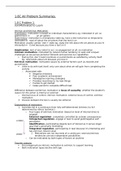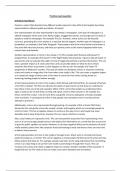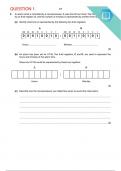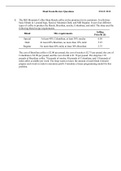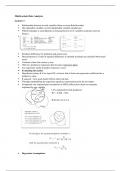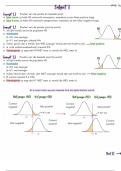Operations Management - 2OC3
Equations & Annotations
Performance Measure
Productivity = Output / Input
Single Factor Productivity
Single Factor Productivity = Output / Single Factor Input
Example:
1,000 cups of coffee were sold using 20 hours of labour, what’s the labour productivity of the
firm?
Labour Productivity = 1, = 50 cups/hr
Multi Factor Productivity
If we look at n kinds of input
,Multi Factor Productivity = Output / Input1 + Input2 + … Inputn
Example:
- 7040 cups of coffee sold
- Cost of labour $1,000
- Cost of materials $520
- Cost of overhead $2,000
1. What’s multi factor productivity?
MFP = 7040 / (1,000 + 520 + 2,000) = 2 cups per dollar invested
Preparation for Critical Path Method
Will store the 4 pieces of info & the activity duration on the node
Earliest Start Time (ES) - Earliest time at which an activity can start
Earliest Finish Time (EF) - Earliest time at which an activity can be finished
Latest Start Time (LS) - Latest time at which an activity can start so as not to delay the
completion time of the entire project
Latest Finish Time (LF) - Latest time at which an activity can be finishes so as not to delay the
completion time of the entire project
Crash Cost Per Time Period
, - $160 = (1,980 - 1,500) / (10 - 7)
- And so on
Labour Productivity
Labour Productivity = Output (# of customers served) / Input (# of hours)
Capacity
Maximum amount that something can contain
Capacity of a process is
- Max # of units a process can output in a given period of time
- Usually a rate (# of units per unit of time)
- Eg. Car manufacturer: 2000 cars/week
- Eg. CIBC branch: 200 customers/day
- Eg. Restaurant: 1000 servings/day
Process Time
Shortest time between 2 outputs
- Process time of a single stage is the time to process a unit
- For a serial process, its process time is equal to the process time of the bottleneck
Capacity can be calculated from a process time
Capacity = 1 / Process Time
System Capacity = Bottleneck Capacity = 1 / Process Time of Bottleneck
Process time will be the bottleneck
Throughput/Output Rate
Rate at which the process is delivering output at some point in a unit of time (# of flow units per
unit of time)
How is capacity different from throughput rate?
- Capacity ≥ Throughput (output) Rate
, Throughput rate depends on
- Demand (input) rate
- Process capacity
Output Rate = Min {Input Rate, Capacity}
Example
If customers arrive at checkout every 4 mins, what is the output rate?
Capacity = 20 customers/hr
Input Rate = ¼ customers/min or 15 customers/hr
Output Rate = Min {20,15} = 15 customers/hr
Utilization
% of time the station/operator is busy
Utilization = Output Rate / Capacity
Using the same example
- Utilization = 15/20 = 0.75 or 75%
Note: Highest utilization is the bottleneck
Process Cycle (Flow) Time
Time for a unit to go through the entire empty system
Process Capacity
Maximum rate at which the process could be delivering output (in # of flow units per unit of
time)
Process Capacity = Min {Capacity of first set of stations, … ,capacity of last set of stations}
The set of stations with the smallest capacity is called the bottleneck
Process Capacity = Capacity of the bottlenecks
Arrival & Service
Equations & Annotations
Performance Measure
Productivity = Output / Input
Single Factor Productivity
Single Factor Productivity = Output / Single Factor Input
Example:
1,000 cups of coffee were sold using 20 hours of labour, what’s the labour productivity of the
firm?
Labour Productivity = 1, = 50 cups/hr
Multi Factor Productivity
If we look at n kinds of input
,Multi Factor Productivity = Output / Input1 + Input2 + … Inputn
Example:
- 7040 cups of coffee sold
- Cost of labour $1,000
- Cost of materials $520
- Cost of overhead $2,000
1. What’s multi factor productivity?
MFP = 7040 / (1,000 + 520 + 2,000) = 2 cups per dollar invested
Preparation for Critical Path Method
Will store the 4 pieces of info & the activity duration on the node
Earliest Start Time (ES) - Earliest time at which an activity can start
Earliest Finish Time (EF) - Earliest time at which an activity can be finished
Latest Start Time (LS) - Latest time at which an activity can start so as not to delay the
completion time of the entire project
Latest Finish Time (LF) - Latest time at which an activity can be finishes so as not to delay the
completion time of the entire project
Crash Cost Per Time Period
, - $160 = (1,980 - 1,500) / (10 - 7)
- And so on
Labour Productivity
Labour Productivity = Output (# of customers served) / Input (# of hours)
Capacity
Maximum amount that something can contain
Capacity of a process is
- Max # of units a process can output in a given period of time
- Usually a rate (# of units per unit of time)
- Eg. Car manufacturer: 2000 cars/week
- Eg. CIBC branch: 200 customers/day
- Eg. Restaurant: 1000 servings/day
Process Time
Shortest time between 2 outputs
- Process time of a single stage is the time to process a unit
- For a serial process, its process time is equal to the process time of the bottleneck
Capacity can be calculated from a process time
Capacity = 1 / Process Time
System Capacity = Bottleneck Capacity = 1 / Process Time of Bottleneck
Process time will be the bottleneck
Throughput/Output Rate
Rate at which the process is delivering output at some point in a unit of time (# of flow units per
unit of time)
How is capacity different from throughput rate?
- Capacity ≥ Throughput (output) Rate
, Throughput rate depends on
- Demand (input) rate
- Process capacity
Output Rate = Min {Input Rate, Capacity}
Example
If customers arrive at checkout every 4 mins, what is the output rate?
Capacity = 20 customers/hr
Input Rate = ¼ customers/min or 15 customers/hr
Output Rate = Min {20,15} = 15 customers/hr
Utilization
% of time the station/operator is busy
Utilization = Output Rate / Capacity
Using the same example
- Utilization = 15/20 = 0.75 or 75%
Note: Highest utilization is the bottleneck
Process Cycle (Flow) Time
Time for a unit to go through the entire empty system
Process Capacity
Maximum rate at which the process could be delivering output (in # of flow units per unit of
time)
Process Capacity = Min {Capacity of first set of stations, … ,capacity of last set of stations}
The set of stations with the smallest capacity is called the bottleneck
Process Capacity = Capacity of the bottlenecks
Arrival & Service

